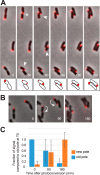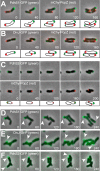Polar Organizing Protein PopZ Is Required for Chromosome Segregation in Agrobacterium tumefaciens
- PMID: 28630129
- PMCID: PMC5553026
- DOI: 10.1128/JB.00111-17
Polar Organizing Protein PopZ Is Required for Chromosome Segregation in Agrobacterium tumefaciens
Abstract
Despite being perceived as relatively simple organisms, many bacteria exhibit an impressive degree of subcellular organization. In Caulobacter crescentus, the evolutionarily conserved polar organizing protein PopZ facilitates cytoplasmic organization by recruiting chromosome centromeres and regulatory proteins to the cell poles. Here, we characterize the localization and function of PopZ in Agrobacterium tumefaciens, a genetically related species with distinct anatomy. In this species, we find that PopZ molecules are relocated from the old pole to the new pole in the minutes following cell division. PopZ is not required for the localization of the histidine kinases DivJ and PdhS1, which become localized to the old pole after PopZ relocation is complete. The histidine kinase PdhS2 is temporally and spatially related to PopZ in that it localizes to transitional poles just before they begin to shed PopZ and disappears from the old pole after PopZ relocalization. At the new pole, PopZ is required for tethering the centromere of at least one of multiple replicons (chromosome I), and the loss of popZ results in a severe chromosome segregation defect, aberrant cell division, and cell mortality. After cell division, the daughter that inherits polar PopZ is shorter in length and delayed in chromosome I segregation compared to its sibling. In this cell type, PopZ completes polar relocation well before the onset of chromosome segregation. While A. tumefaciens PopZ resembles its C. crescentus homolog in chromosome tethering activity, other aspects of its localization and function indicate distinct properties related to differences in cell organization.IMPORTANCE Members of the Alphaproteobacteria exhibit a wide range of phenotypic diversity despite sharing many conserved genes. In recent years, the extent to which this diversity is reflected at the level of subcellular organization has become increasingly apparent. However, which factors control such organization and how they have changed to suit different body plans are poorly understood. This study focuses on PopZ, which is essential for many aspects of polar organization in Caulobacter crescentus, but its role in other species is unclear. We explore the similarities and differences in PopZ functions between Agrobacterium tumefaciens and Caulobacter crescentus and conclude that PopZ lies at a point of diversification in the mechanisms that control cytoplasmic organization and cell cycle regulation in Alphaproteobacteria.
Keywords: Agrobacterium; PopZ; cell division; cell polarity; chromosome segregation.
Copyright © 2017 Ehrle et al.
Figures






Similar articles
-
Absence of the Polar Organizing Protein PopZ Results in Reduced and Asymmetric Cell Division in Agrobacterium tumefaciens.J Bacteriol. 2017 Aug 8;199(17):e00101-17. doi: 10.1128/JB.00101-17. Print 2017 Sep 1. J Bacteriol. 2017. PMID: 28630123 Free PMC article.
-
Loss of PopZ At activity in Agrobacterium tumefaciens by Deletion or Depletion Leads to Multiple Growth Poles, Minicells, and Growth Defects.mBio. 2017 Nov 14;8(6):e01881-17. doi: 10.1128/mBio.01881-17. mBio. 2017. PMID: 29138309 Free PMC article.
-
Loss of PodJ in Agrobacterium tumefaciens Leads to Ectopic Polar Growth, Branching, and Reduced Cell Division.J Bacteriol. 2016 Jun 13;198(13):1883-1891. doi: 10.1128/JB.00198-16. Print 2016 Jul 1. J Bacteriol. 2016. PMID: 27137498 Free PMC article.
-
End-in-Sight: Cell Polarization by the Polygamic Organizer PopZ.Trends Microbiol. 2018 Apr;26(4):363-375. doi: 10.1016/j.tim.2017.11.007. Epub 2017 Nov 29. Trends Microbiol. 2018. PMID: 29198650 Review.
-
Crosstalk Regulation Between Bacterial Chromosome Replication and Chromosome Partitioning.Front Microbiol. 2019 Feb 26;10:279. doi: 10.3389/fmicb.2019.00279. eCollection 2019. Front Microbiol. 2019. PMID: 30863373 Free PMC article. Review.
Cited by
-
Interacting bactofilins impact cell shape of the MreB-less multicellular Rhodomicrobium vannielii.PLoS Genet. 2023 May 31;19(5):e1010788. doi: 10.1371/journal.pgen.1010788. eCollection 2023 May. PLoS Genet. 2023. PMID: 37256900 Free PMC article.
-
Agrobacterium tumefaciens: a Transformative Agent for Fundamental Insights into Host-Microbe Interactions, Genome Biology, Chemical Signaling, and Cell Biology.J Bacteriol. 2023 Apr 25;205(4):e0000523. doi: 10.1128/jb.00005-23. Epub 2023 Mar 9. J Bacteriol. 2023. PMID: 36892285 Free PMC article. Review.
-
The Polar Organizing Protein PopZ Is Fundamental for Proper Cell Division and Segregation of Cellular Content in Magnetospirillum gryphiswaldense.mBio. 2019 Mar 12;10(2):e02716-18. doi: 10.1128/mBio.02716-18. mBio. 2019. PMID: 30862753 Free PMC article.
-
Stable inheritance of Sinorhizobium meliloti cell growth polarity requires an FtsN-like protein and an amidase.Nat Commun. 2021 Jan 22;12(1):545. doi: 10.1038/s41467-020-20739-3. Nat Commun. 2021. PMID: 33483499 Free PMC article.
-
Agrobacterium tumefaciens Growth Pole Ring Protein: C Terminus and Internal Apolipoprotein Homologous Domains Are Essential for Function and Subcellular Localization.mBio. 2021 May 18;12(3):e00764-21. doi: 10.1128/mBio.00764-21. mBio. 2021. PMID: 34006657 Free PMC article.
References
MeSH terms
Substances
Grants and funding
LinkOut - more resources
Full Text Sources
Other Literature Sources

